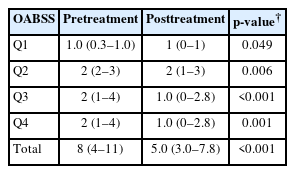-
Efficacy of Urovaxom for Improving Chronic Pelvic Pain Syndrome Symptoms in Prostate Cancer Patients Who Underwent Radical Prostatectomy: A Multicenter, Prospective Cohort Study
-
Jun-Koo Kang, Yun-Sok Ha, Sungchan Park, Tae Gyun Kwon, Tae-Hwan Kim
-
Urogenit Tract Infect 2025;20(1):42-47. Published online April 30, 2025
-
DOI: https://doi.org/10.14777/uti.2550014007
-
-
 Abstract Abstract
 PDF PDF PubReader PubReader ePub ePub
- Purpose
Chronic pelvic pain syndrome (CPPS) is a multifactorial condition that can significantly diminish quality of life. Although some patients have reported persistent pelvic pain after radical prostatectomy (RP), the prevalence and direct causal relationship between CPPS and RP remain unclear. This multicenter prospective study aimed to evaluate the efficacy of Urovaxom for improving CPPS symptoms.
Materials and Methods: A total of 52 prostate cancer patients who underwent RP were enrolled and administered Urovaxom (60 mg/day) for 12 weeks. Changes in National Institutes of Health Chronic Prostatitis Symptom Index (NIH-CPSI), overactive bladder symptom score (OABSS), International Prostate Symptom Score (IPSS), and inflammation markers (white blood cell [WBC], C-reactive protein [CRP]) were analyzed using the Wilcoxon signed-rank test.
Results
After 12 weeks of treatment, the NIH-CPSI total score significantly decreased from 19 (interquartile range [IQR], 16–23) to 12.5 (IQR, 8.0–16.8) (p<0.001). The OABSS total score decreased from 8 (IQR, 4–11) to 5 (IQR, 3.0–7.8), and the IPSS total score decreased from 13.5 (IQR, 10.0–22.8) to 10.5 (IQR, 5.0–17.0) (p<0.001). WBC levels showed a slight increase (p=0.028), but the clinical relevance of this change is uncertain and warrants further investigation. CRP changes were not statistically significant (p=0.274).
Conclusions
Urovaxom demonstrated significant efficacy in improving CPPS symptoms, particularly pain and reduced quality of life, in patients following RP. These findings suggest Urovaxom as a potential therapeutic option for CPPS after management using RP.
-
Citations
Citations to this article as recorded by  - Editorial for UTI 2025 Vol. 20 No. 1 - Highlights of This Issue’s Papers and the UTI Editors’ Pick
Koo Han Yoo
Urogenital Tract Infection.2025; 20(1): 1. CrossRef - Addressing an Unmet Need in Postprostatectomy Care: Perspectives on Urovaxom
Byeong Jin Kang
Urogenital Tract Infection.2025; 20(2): 118. CrossRef
-
2,622
View
-
34
Download
-
2
Crossref
-
Urinary Tract Infection and Bladder Dysfunction in Children
-
Sungchan Park, Kun Suk Kim
-
Korean J Urogenit Tract Infect Inflamm 2008;3(2):149-161. Published online October 31, 2008
-
-
-
 Abstract Abstract
 PDF PDF
- Recognition that bacteriuria may cause renal parenchymal and functional loss has prompted recommendations for rapid diagnosis and evaluation of urinary tract infection (UTI). Rapid recognition of a UTI and rapid and appropriate treatment with antibiotics are important to prevent renal damage. The goal of UTIs management in children is based on identifying and modifying factors that may increase risk of renal parenchymal and functional loss. Various factors for UTI in children appear to be distinct for each individual and should be evaluated to find associated disease. Symptoms of nocturnal and diurnal incontinence are common in children with recurrent UTIs. Urodynamic study in neurologically normal children with recurrent UTI and incontinence has shown abnormal cystometry and voiding pattern. Bacteriuria or constipation may provoke abnormal detrusor-sphincter activity or vice versa. There is an important relationship between constipation, detrusor instability, reflux, UTI, and enuresis. Overall approach and management in children with UTI and bladder dysfunction should therefore be needed.
|






